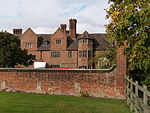Royal Oak

The Royal Oak is the English oak tree within which the future King Charles II of England hid to escape the Roundheads following the Battle of Worcester in 1651. The tree was in Boscobel Wood, which was part of the park of Boscobel House. Charles told Samuel Pepys in 1680 that while he was hiding in the tree, a Parliamentarian soldier passed directly below it. The story was popular after the Restoration, and is remembered every year in the English traditions of Royal Oak Day. Numerous large slipware dishes (known as 'chargers') depicting the Boscobel Oak were made by the Staffordshire potter Thomas Toft. The oak tree is shown being supported by the Lion and Unicorn, with the king's face peeping from the branches.
Excerpt from the Wikipedia article Royal Oak (License: CC BY-SA 3.0, Authors, Images).Royal Oak
Shackerley Lane, South Staffordshire
Geographical coordinates (GPS) Address External links Nearby Places Show on map
Geographical coordinates (GPS)
| Latitude | Longitude |
|---|---|
| N 52.67008 ° | E -2.24185 ° |
Address
The Royal Oak
Shackerley Lane
ST19 9AR South Staffordshire
England, United Kingdom
Open on Google Maps









